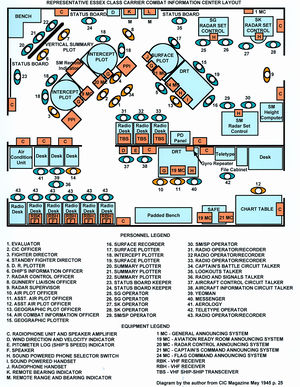The Gilbert and Marshall Islands - Chapter 10 of Radar and the Fighter Directors
By David L. Boslaugh, Capt USN, Retired
New Carriers
In his 8 May 1942 action report of the Battle of the Coral Sea, CAPT Buckmaster listed two pages of recommendations regarding needed improvements in Yorktown’s radar plotting and fighter direction facilities, and he also recommended that fleet carriers should have two air search radars. Chief of Naval Operations, Admiral Ernest J. King, in his comments on the action report wrote, “...this project is well in hand for new construction.” USS Essex, the lead ship of a new class of twenty-four new fleet carriers, and USS Independence, leading a nine-ship class of light carriers, were commissioned on 31 December 1942 and 14 January 1943, respectively. They embodied the recommended improvements with well equipped, spacious CICs. After much argument, the new CICs were not located in the island but rather below decks where they were better shielded not only from battle damage but also from curious interlopers and onlookers. In all new-construction cruisers, destroyers, and battleships their CICs were likewise moved away from the bridge as was also done in older ships when they came into shipyards for overhaul. [13, pp.28-29]
As recommended, all new carriers had two air search radars: an SK as primary and an SC-2 or SG as secondary. These radars featured remote plan position indicators located at stations throughout the CIC. Each PPI could be switched to either air search radar, or to a surface search radar. Fighter directors now had the option of conducting intercepts either from plotting boards or directly on the PPI scope. U.S. designers also followed the British practice of separating the fighter direction plot from the air summary plot. They also used another British innovation, the edge-lit transparent vertical summary plot. Both navies had originally struggled with finding enough room in a crowded radar plotting room for a situation plot. The large map tables in Battle of Britain operations rooms were out of the question in a crowded ship. Both navies had resorted to large blackboards with an imprinted polar coordinate system, but they posed problems. The summary plot had to be marked by at least two plotters; one entering radioed off-ship radar data, and one entering own-ship radar data. Furthermore, a filtering officer had to stand at the plot to resolve mismatches, raid splits, and turns. With all these people working on the summary board, the FDO could hardly see the plot. Legend has it the solution came from a British Army regiment that had devised a small status board that could be read in the dark. Someone had found that if a sheet of plexiglass were edge lighted with ultraviolet light, a grease pencil mark on the sheet would glow in the dark. The system worked just as well on a large plexiglass sheet, and the genius of the arrangement was that the radar plotters could mark their grease penciled tracks on the back side of the transparent plot, and the filter officer could stand on the front side to resolve discrepancies. The glowing plot could be easily read throughout the CIC. The only drawback was that the plotters had to learn to write annotations such as time and raid numbers in mirror image writing so people out in front could read them. [42, p.100] [9, p.369]
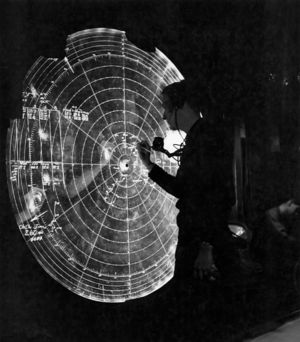
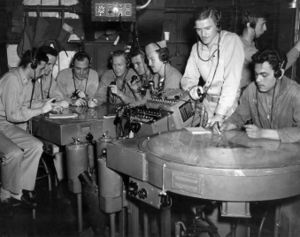
The new Lexington was commissioned on 17 February 1943, and during fitting out in March she received the prototype of the long sought after height finding radar. We have previously described a number of examples of fighter direction disasters because of inaccurate target altitude estimation. The only recourse when altitude was doubtful was stacking defending fighters at various altitudes, which diluted the number of fighters that could actually engage the enemy. The cavity magnetron finally gave the Navy the sought after height finding radar when it was incorporated in an army SCR-584 gun laying (fire control) radar. This ten-centimeter radar was so successful that the Navy was inspired to develop a shipboard version, the prototype of which was designated CXBL. It featured a narrow beam that could measure target elevation or bearing to within one half of a degree, could detect a bomber at fifty nautical miles, and a battleship at twenty-five nautical miles. It had a PPI display with range scales extending out to 80 nautical miles, and because of its very short wavelength it could track targets into short ranges where targets were obscured on the CXAM and SK radars.
The CXBL used a large parabolic antenna that, because of ship’s pitch and roll, had to be mechanically stabilized which made it an unusually heavy antenna, at nine tons. This weight was too much for the new light carriers (CVL), having the potential to make them top-heavy, so it was installed only in the large fleet carriers. After successful testing in the new Lexington, the radar went into production by the General Electric Company. The production version was designated SM, and twenty-three were produced in all. The first two production sets were installed in the new Essex Class carrier Bunker Hill and in Enterprise in September and October 1943. All twenty-three would be at sea by the end of 1944. Because of its narrow beam, the SM was not useful as a search radar, and had to be coached on to its target by an air search radar such as the SK, but once locked on, the fighter director finally had his accurate target altitude. The SM radar developer, MIT Radiation Laboratory, was eventually able to cut SM’s weight in half, resulting in a new version, designated SP, that could be installed in battleships, and cruisers. A few were even installed in specialized destroyers. [10, p.368]
In the summer of 1943 another long sought equipment item was finally introduced to the fleet. The new “super frequency” VHF radios arrived in shipyards and were quickly installed throughout the fleet. They each had four channels capable of being rapidly switched. Now communications between the FDO and pilots could be on one channel, while a separate channel could be used for communication among FDOs on different ships. Different patrol and strike groups could be assigned their own channels, greatly uncluttering the fighter net. The line of sight characteristic of the higher frequency would allow intercept practice at sea without concern for giving away fleet location. [13, p.29]
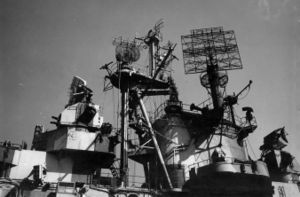
To make best use of the new Yorktown’s expanded CIC facilities and radar suite, she needed a trained and experienced fighter direction officer. Her executive officer, CAPT Raymond R. Waller found one in LTJG Charles D. Ridgway III, a graduate of the first San Diego FDO class, and up for reassignment. Waller proposed the assignment to Yorktown’s new commanding officer, CAPT Joseph J. Clark, but there was hesitation. Clark already had a CIC officer, LT Cooper B. Bright, and he was hesitant to downgrade an officer who was doing a good job. Waller wanted the best obtainable FDO, and Ridgeway had an outstanding reputation. After considerable argument, they came to a compromise. Usually the FDO was also the CIC officer, but in an unusual arrangement Bright would remain as CIC officer and Ridgway would be called the fighter director officer. ADM Clark writes he never regretted the arrangement. He also notes, he made frequent trips down to the CIC to make sure their intercepts were being run properly. This was a little disconcerting to LT Bright who always made sure he looked busy, even if he had to pick up a telephone and talk to a nonexistent person on the other end. [16, p.120]
On 31 August 1943, Essex, Yorktown, and the new light carrier Independence staged fighter and bomber strikes against the Japanese garrison on Marcus Island about 1000 miles east of the Japanese home islands. This gave them a chance to try out their new CICs and radios. In this raid Independence, carrying twenty-four fighters, provided most of the combat air patrol, in line with previous recommendations that one carrier in a task force should provide all the defending fighters so that pilots and their controlling FDO were familiar with each other. This action marked the first use of the new Grumman F6F “Hellcat” fighter, and the new VHF radios got a workout. The OTC in his action report wrote, “VHF radio frequencies ... are very valuable for important immediate communications such as maneuvering signals, combat information and fighter direction.” He also noted that strike communications planners had assigned the same frequency for the Inter Fighter Director Net (for communicating among CICs) and inter-plane communications, with the result that the channel was greatly overcrowded. He recommended developing new radios with more than four channels. The OTC concluded, however, “In spite of the almost continuous transmissions on these circuits each bogey approaching any surface formation was successfully intercepted. No enemy planes approached within range of surface gunfire. With this in view Task Force VHF communications were considered on this mission satisfactory.” [20, p.123] [13, pp.29-30]
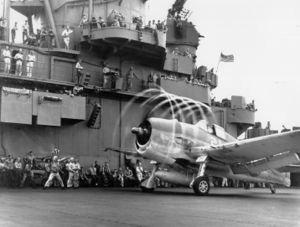
On five and six October 1943, Essex, Lexington, Yorktown, and the light carrier Cowpens accompanied by a surface force of heavy gun ships made air and shore bombardment raids on Japanese-held Wake Island. As the raids progressed into the afternoon, ADM Clark writes the Japanese garrison on Wake radioed continuously for help, which brought attackers down from Japanese bases in the Northern Marshall Islands, and gave FDO Charlie Ridgway a busy afternoon. His new PPI scopes showed two groups of Japanese planes inbound, and Ridgway vectored his CAP out to meet them. The flight leaders reported that each of the two groups was made up of six bombers and six fighters. The Hellcats promptly brought down ten of the attackers, and the rest elected to break off the engagement and land on Wake Island. Toward dusk, the survivors were worked over by six USN Liberator bombers from Midway who came to photograph the damage.
Raid action reports noted that again the FDO and fighter nets had been combined, with the same complaint by the OTC that new radio equipment with more than four channels was needed. Cruisers had been assigned fighter direction for the CAP protecting the bombardment ships, and they had improvised VHF installations. In most cases, the arrangement worked, but on the cruiser Santa Fe, fighter director communications were unworkable. This prompted the task force commander to write,
If any value is to be obtained by surface ships from the Combat Patrols furnished them, these ships (including transports) must be equipped with VHF radio; they must have qualified Fighter Directors on board and their CIC organization, space and equipment must be enlarged to handle this function.
With respect to the prototype CXBL height finding radar, which some already called a fighter director radar. Lexington’s skipper reported,
CXBL radar performance, aside from material breakdown suffered, was good. It consistently picked up targets to its maximum range. Detection of low flying aircraft was excellent. The weakest part of this type is the identification feature….Extremely high flying aircraft are difficult to pick up because of the searchlight type of detection.... Close coordination is necessary between this type radar and the standard air search radar.
CO Lexington also noted that the CXBL was effective in determining raid size and vertical composition. [13, pp.29-30] [16, p.128]
The Gilberts
The carriers Lexington, Yorktown and Cowpens, on 18 November 1943, arrived at stations between the Marshall Islands and the Gilbert Islands, their purpose to intercept Japanese air strikes expected to come south from the Marshalls when American Marines stormed the islands of Tarawa and Makin in the Gilberts on the morning of 20 November. On the 20th, each of the three task groups sent a destroyer, with covering CAP, thirty thousand yards in advance of the main group to give advance warning of expected raids. They would also have charge of directing their CAP, however, primary fighter direction remained in the CICs of the three carriers. CAPT Clark in Yorktown required his FDO LTJG Charles Ridgway to send CAP out to look over every pip that appeared on the radar. If it was confirmed friendly, Ridgway merely recalled the fighters.
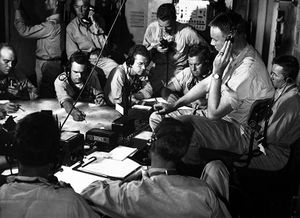
Daytime fighter direction remained effective, but nighttime fighter direction was still a problem because of the lack of radar equipped interceptors. On the night of 20 November the Japanese sent twenty twin-engine, torpedo laden Mitsubishi G4M bombers from the Marshalls. They broke through the fighter defenses and hit the light carrier Independence supporting the invasion beaches. Her casualties were heavy and she was so badly damaged that many months of repairs would be needed. ADM Clark writes that defense against night air attacks was so inadequate that in one nighttime raid the Task Force commander brought his ships to a stop so that the attackers could not see their phosphorescent wakes. It worked that time, but Clark notes that if the enemy had seen them, the consequences would have been unacceptable. On 23 November, Yorktown’s radar operators detected another raid coming from the Marshalls, and again Ridgway vectored his CAP out. This time the Hellcats shot down an uncounted number of the raiders, and turned the others back. By 26 November, Tarawa and Makin were in American hands, and CINCPAC ordered the carriers to new stations. While doing so on the night of the 26th, a group of thirty Japanese planes attacked the Enterprise task group, but this time the task group commander Rear Admiral Arthur W. Radford had a surprise ready for the nighttime raiders. [16, p.133, p.137]
Enterprise carried a squadron of Grumman Avenger torpedo bombers equipped with anti-submarine air-to-surface-vessel (ASV) radar. Experiments had shown the ASV could also detect air targets, and Enterprise’s Air Group Commander, LCDR John Phillips, and LCDR Butch O’Hare, Enterprise’s Fighter Squadron Commander, had convinced Radford to let them try a night intercept using the Avenger’s radar. The scheme was to have two Hellcats fly wing on the Avenger, who would be vectored on to a bandit by the ship’s FDO. The Avenger would then use its radar to try to find the target and bring the flight to visual detection range. On the night of 24 November two Avengers with fighters tried without luck to find a raid attacking Tarawa. This would be the first ever carrier-borne night fighter mission. On the night of the 26th two flights of Avengers, accompanied by two fighters each, had more success when O’Hare brought down a twin-engine bomber. The second group under the command of LCDR Phillips brought down two more. But an unidentified plane attempted to join Phillip’s group, and the gunner in the Avenger turret brought it under fire. It is not known for sure if that is what brought O’Hare down, but he was last seen dropping away after the encounter, and declared missing in action. The thirty-plane raid was broken up at the cost of LCDR O’Hare’s life. [26] [16, p.137] [20, p.124]
From lessons learned in the Gilberts and other operations, the Chief of Naval Operations issued an updated Current Tactical Orders and Doctrine, U.S. Fleet [USF 10A] containing new radar and fighter direction doctrine that was more specific than past doctrine. It included:
- A reiteration that the Officer in Tactical Command was responsible for fighter direction and radar control.
- Ships commanding officers were responsible for organizing their CICs, and training their personnel.
- When given an estimate of a raid’s altitude, flight leaders were to stack their planes so they would get visual contact at the earliest possible time, and they were to ensure they had high cover.
- Standard diagrams were issued for various types of daytime and nighttime intercepts.
- During daylight hours, a visual FDO was to be stationed in the superstructure of fighter direction ships to receive lookout reports, plot visually detected airplanes, and be prepared to take over fighter direction against raiders that had broken in close to the formation.
- Various types of orbiting intercepts were described, along with the advantages and disadvantages of each.
- The figure-of-eight orbit was the preferred orbit for most occasions.
Much of the new doctrine had already been anticipated and tried in the Gilberts operation, and Commander Fifth Fleet would work it into his plan for the next push, the capture of the Marshall Islands. [13, pp30-31]
By the end of 1943, dedesignated experienced FDOs were authorized to commence interceptions on their own initiative, and report their actions immediately to the Task Group FDO. Soon after, these FDOs were also allowed to change altitude and stations of assigned CAPs as required by the tactical situation. [52, p.257]
The Amphibious Force Flagships
In his comments on the Guadalcanal landing, Chief of Naval Operations, Admiral Ernest J. King, had expressed the need for a specially equipped ship to serve as a command center for amphibious operations. To support the Sicily invasion in July 1943 a former troop transport, USS Ancon, had been outfitted with extra radars, enlarged CIC, plotting rooms and staff facilities to provide this function. In this case, fighter direction was done aboard the attack transport Monrovia by a team of army controllers directing army fighters. During the September Salerno invasion, army fighter directors were embarked in Ancon to control army fighters over the beaches while Royal Navy fighter directors aboard the anti-aircraft Ship HMS Ulster Queen controlled carrier airplanes. Experience with Ancon showed the value of ships outfitted for amphibious force command and sparked a new construction program.
The first three ships built specifically as amphibious force flagships, designated AGC, were:
- USS Appalachian (AGC 1) commissioned 2 October 1943,
- USS Blue Ridge (AGC 2) commissioned 27 September 1943, and
- USS Rocky Mount (AGC 3) commissioned 15 October 1943.
Their radar complement was one SK large-ship air search radar, two SG microwave surface search radars, and a small portable emergency radar. Relatively small CICs were built into the superstructure. In the beginning the CICs did not have standard plotting tables, just ordinary tables. They had one remote PPI radar scope, and the SK radar set control was in an adjoining room. Later, before deploying to the Pacific, Rocky Mount was refitted with a larger CIC on the main deck next to the Joint Operations Room. The new CIC had standard intercept plotting tables, a large vertical summary plot, one remote PPI scope, and a dead reckoning tracer. One enclosed corner of the CIC housed the SK radar set control and one SG surface search PPI. The other two AGCs went off to war with the older layout. [13, p.32]
The amphibious force flagships were provided a team of radar operators, a CIC/Fighter Director Officer, and eight assistant CIC officers, all qualified as FDOs. Their CICs worked primarily to maintain a complete radar picture of the invasion area from own-ship and other ship’s radars, and from dispatches. The CIC/FDO Officer was concerned primarily with keeping the invasion commander updated on the tactical air situation, sending out invasion force air warnings, and stationing/coordinating picket destroyers. The CIC Officer or his assistants occasionally conducted live intercepts, but this was not their primary function. Appalachian and Rocky Mount first saw combat when they supported the Marshall Islands Kwajelein Atoll invasion in January 1944. Combat Information Center spaces were enlarged in follow-on AGCs to allow more status boards and blackboards, improved plotting tables, and vertical summary plots. As with other ship classes, fighter direction experience reinforced the need for height finding radar. Finally in November 1944, USS Eldorado (AGC 11), fitted with an SP height finding radar, joined the Pacific Fleet. [13, p.33]
The Marshall Islands
The Marshall Island group is located in the North Pacific some 2,500 miles northeast of the Australian coast, and includes Kwajelein Atoll, a ring of islands. Japanese naval installations on Roi-Namur Island, the northernmost island of the atoll, included the command center of the Marshall Islands defense forces. On 4 December 1943, a U.S. carrier task group including Lexington, Yorktown, and the light carrier Cowpens, with a supporting force of cruisers and destroyers, launched a strike against ships and facilities at Roi-Namur. The purpose, to soften the island’s defenses in preparation for invasion. The strike force sank three transports, damaged a cruiser, and destroyed eighteen seaplanes. On Roi Island they strafed more than sixty twin-engine Mitsubishi G4M torpedo bombers, but left the bulk of them intact. Returning pilots told the task group commander Rear, Admiral Charles A Pownall, of the large number of intact torpedo bombers remaining, and the commanding officer of Yorktown, CAPT J. J. Clark, urged the admiral to make a second strike to eliminate the G4Ms before they mobilized to counter-strike the task group, which he was sure they would do. ADM Pownall demurred, but did authorize a strike on the Wotje Island airstrip where they had seen six more G4Ms.
Around noon, as the task group was launching the strike against Wotje, torpedo planes appeared as predicted. They came in low below the CAP fighters, and those that were not shot down launched torpedoes, but to no effect. The task force drove off the attackers with no damage to the group, but CAPT Clark was sure they would return, probably that evening while the task group was still within range of the G4Ms. Since the death of Butch O’Hare and his experimental night fighting group, the task group had no night fighters, and the Japanese knew it. They were specialists in the art of night aerial attacks, and the task group’s only nighttime defense would be AA fire and maneuvering. Also to the Japanese advantage that night, the sky was going to be clear and it would be lit by a bright moon. As the sun was setting, task group radar scopes began showing the track of patrol planes making an expanding square search pattern, and they found the group just as dark came on. Yorktown was ADM Pownall’s flagship, which meant her FDO, LTJG Charlie Ridgway, would be in charge of task group air defense; only this time it would be not as a fighter director but as gunnery coordinator. He would be responsible for managing the defense of three carriers, four heavy cruisers, one light cruiser, and six destroyers.
Ridgway’s job would be to keep track of every attacker and, depending on their location and trajectory, assign appropriate ships to engage each raid with gunfire. He also had to advise each ship, based on his radar picture, when it looked like they were about to be under torpedo attack, and where the attacker was. This would allow them to make evasive turns. The attacks came, assisted by Japanese flares as well as moonlight, and lasted for seven and one-half hours until the moon set. During that time, RADM Clark wrote of Ridgway’s performance; every one of his orders was correct; there was never any hesitation; and he never had to repeat an order. His voice was at all times calm, clear, and with perfect diction. People topside saw at least two torpedoes, one missing Yorktown’s bow, and one missing her stern; both misses thanks to adroit maneuvering cued by Ridgway. Clark was very thankful that he had given in to his executive officer and had agreed to take Ridgway on as his Fighter Director Officer.
Lexington was not so lucky. During the battle she had lost speed and slowly slipped to the rear of the ring of screening ships where she had less covering AA fire. The attackers took advantage of her exposure and managed to get one torpedo into her stern. A number of men were killed and her rudder jammed hard to port. The cruiser Oakland came alongside Lexington to provide extra AA fire until the moon providently set. After about half an hour, the wounded carrier could make 21 knots, and would have to steer by engines until she went into a repair facility. The task group had withstood and repulsed what would go down in history as the longest Japanese air attack of the war. [16, pp.138-141]
On 31 January 1943, ships of the 5th Amphibious Force, under the command of RADM Richmond K. Turner aboard the amphibious force flagship Rocky Mount arrived off the beaches of Kwajelein Island, the southernmost island of the atoll. Simultaneously, ships of Group 3 of the 5th Amphibious Force, under the command of RADM R. L. Conolly aboard Appalachian (AGC 1) appeared off Roi-Namur Island. Four days later the two islands were in U.S. hands, and this marked the first Pacific deployment of the new amphibious force flagships. This would also be the first capture of prewar Japanese territory. Each AGC had a team of fighter directors aboard, but there was no business for them this time because there were no flyable Japanese aircraft left on the islands. [36, I: p.52, VI: p.143] [54]
In early February 1944, CAPT Clark of Yorktown was promoted to flag rank and was made Commander Carrier Division 13. He went aboard his flagship, the new fleet carrier Hornet, and one of his first actions was to arrange for detachment of his former FDO, LTJG Charles D. Ridgway, from Yorktown to be his Task Group 58.1 Fighter Director Officer. [16, p.150]
Click here to go to “ The Night Fighters - Chapter 11 of Radar and the Fighter Directors.”
